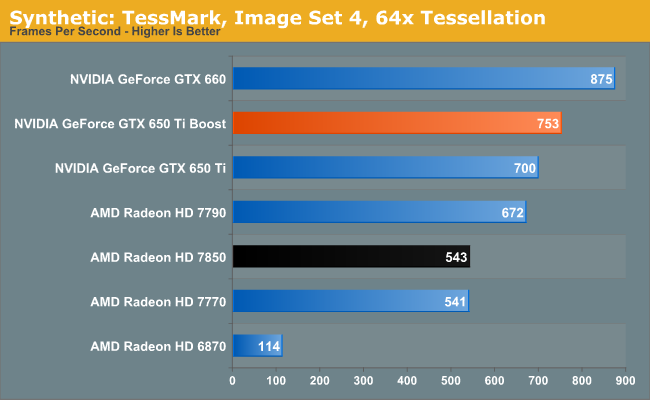NVIDIA GeForce GTX 650 Ti Boost Review: Bringing Balance To The Force
by Ryan Smith on March 26, 2013 8:00 AM ESTSynthetics
As always we’ll also take a quick look at synthetic performance to get a better look at our video cards' underpinnings. These tests are mostly for comparing cards from within a manufacturer, as opposed to directly comparing AMD and NVIDIA cards.
We’ll start with 3DMark Vantage’s Pixel Fill test, a mix of a ROP test and a bandwidth test to see if you have enough bandwidth to feed those ROPs.

3DMark Vantage’s pixel fill test confirms what we know from the specs of the GTX 650 Ti Boost: that it has received a massive boost in ROP performance and memory bandwidth. The 45% greater pixel throughput rate here doesn’t reach the kind of lofty goals that the theoreticals would put it at, but it’s clearly quite an improvement. Interestingly despite the equal ROP throughput and memory bandwidth of the GTX 660 and GTX 650 Ti Boost, the GTX 660 is still clearly in the lead here. We’ve never looked at the impact of GPCs here, so if our card is a 2 GPC model then this might explain what we’re seeing.
Moving on, we have our 3DMark Vantage texture fillrate test, which does for texels and texture mapping units what the previous test does for ROPs.

Texture fillrates on the other hand are really only benefitting from the higher clockspeeds of the GTX 650 Ti Boost over the GTX 650 Ti, and memory bandwidth to a much lesser extent. This is why despite the similarities between the GTX 650 Ti Boost and the GTX 660, the latter is still quite safe from the GTX 650 Ti Boost.
Finally we’ll take a quick look at tessellation performance with TessMark. We have everything turned up to maximum here, which means we're looking at roughly 11 million polygons per frame.

NVIDIA has always had a fairly ridiculous geometry throughput rate, and that doesn’t change on the GTX 650 Ti Boost. A score of 753 is second only to the GTX 660, and well ahead of the 7850, which is an interesting confluence of a 2 primative/clock rate, and its lower clockspeeds relative to the 7790 and GTX 650 Ti Boost.










78 Comments
View All Comments
trajan2448 - Wednesday, March 27, 2013 - link
Seems a little disingenuous to avoid comparisons to its direct competitor, the7790, which it handily beats and has better frame delivery times. It wasn't designed to go against the 7850, and you guys know that.FearfulSPARTAN - Wednesday, March 27, 2013 - link
Nvidia seems to thinks so, cant remember the article but Nvidia said the gtx 650 ti boost beat the 7850 in several games, all of them just so happen to be nvidia optimized games though.Ryan Smith - Friday, March 29, 2013 - link
At $169 for the model we reviewed it sure is. It's the $149 1GB card that we need to look at if we want to make meaningful 7790 comparisons.marees - Wednesday, March 27, 2013 - link
"the best card is going to be the card you can afford."The above conclusion should be revised as "the best card is going to be the card+power_supply+cooling_solution you can afford."
I would like a gddr5 card <=$200 which can play latest games at 1080p at the max settings allowed by budget. But I dont want to screw-up my entire pc due to wrong choice of Power Supply or Cooling system/case.
I am sure this has been discussed somewhere before, if not can Anand and his team create a bench / post article to analyse the playable settings of different gddr5 cards along with the additional investment required in terms of case & power supply, esp from a budget gamer point of view - a person for whom it is nice to be able to game, but actually uses the pc mostly for browsing facebook and doing office work.
rbfowler9lfc - Wednesday, March 27, 2013 - link
Why "Ti Boost"? GTX 660, 660Ti, 650, 650Ti and now 650TiB. So many suffixes, that's confusing for the average joe! Why not just plain GTX 655?!?MrSpadge - Tuesday, April 2, 2013 - link
Agreed - this is totally ridiculous!They've already got up to 3 letters for prefixes (but always use the same GTX on any card half-interesting for actual 3D work), 100 different numbers in each generation, now an additional suffix "Ti". Yet that's still not enough, we need another suffix...
Based on performance these should be:
GT640 - GT640
GTX650 - GTX640
GTX650Ti - GTX650
GTX650Ti Boost - GTX655
Darbyothrill - Thursday, March 28, 2013 - link
This may very understandably not be a big consideration for many people, but this card appeals to me a great deal as I am interested in running a Steam Linux Box, and the AMD drivers are currently in an atrocious state for linux. I overall think the AMD cards are more compelling for the price right now, but this is a decently priced nVidia solution.vaibhav81 - Friday, April 12, 2013 - link
guys,I am going to build custom gaming pc. And I Have selected this card for my pc.Can you suggest me other compatible hardware requirement for this,e.g.MotherBoard,PSU,Processor,Case,monitor??lower price will be good.